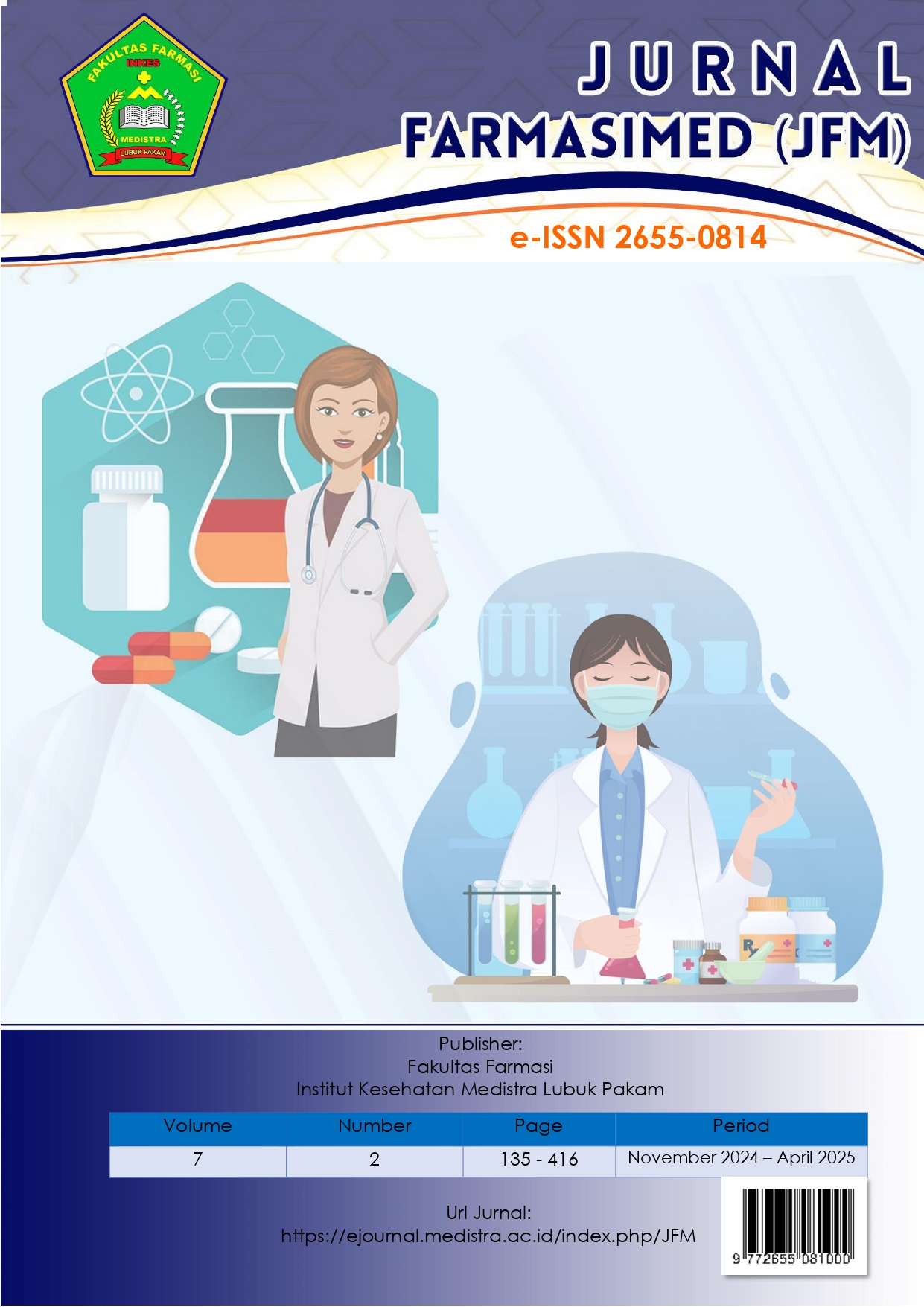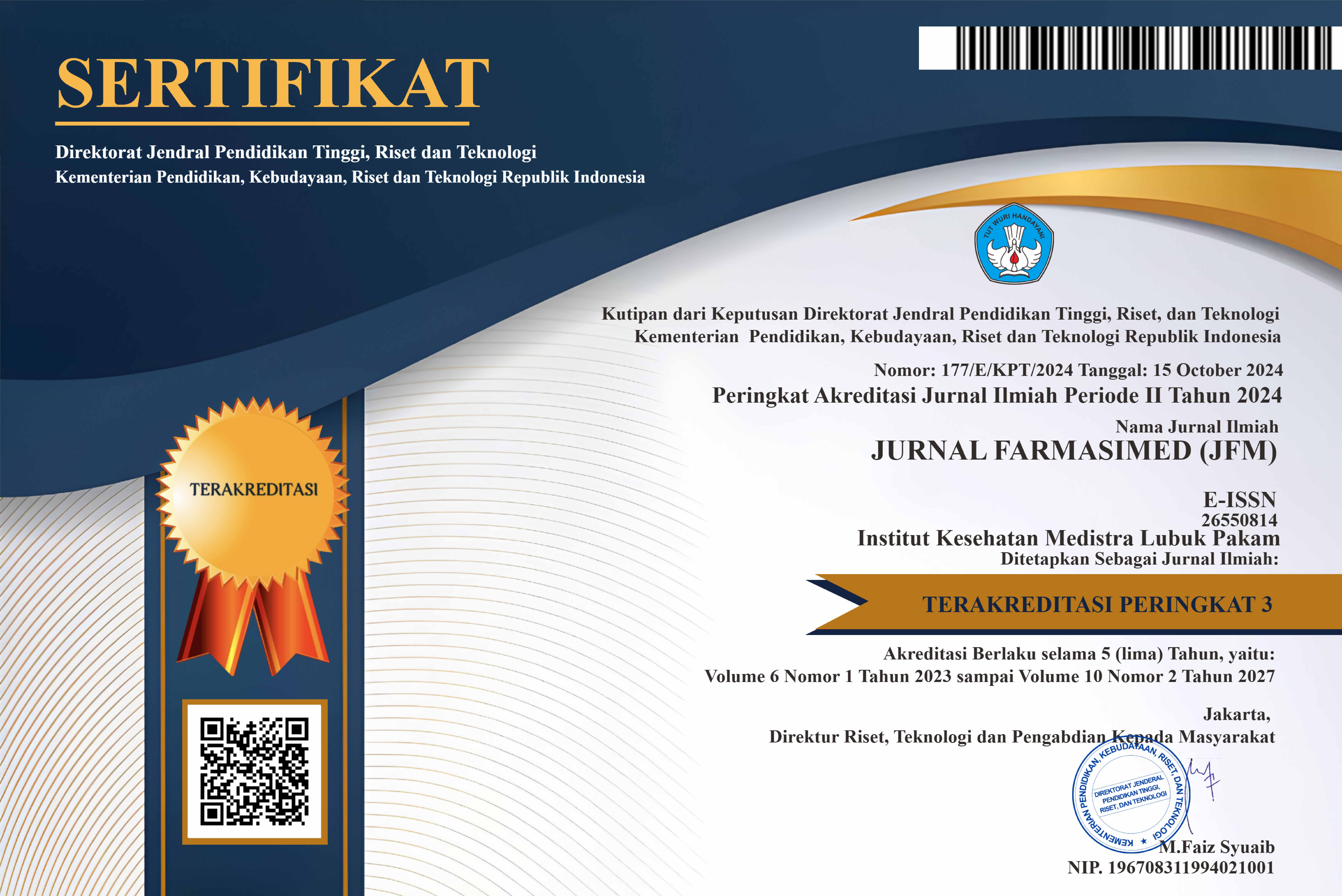Isolation and Structural Elucidation of Flavonoid Compounds from Ciplukan (Physalis angulata L.) Leaf Extract
DOI:
https://doi.org/10.35451/jfm.v7i2.2667Keywords:
Ciplukan Leaves, Elucidation, Isolation, Flavonoid CompoundsAbstract
The exploration and utilization of herbal medicines continue to expand due to the presence of plant-derived secondary metabolites, which have been proven to prevent and treat various diseases with minimal side effects. One plant widely recognized for its medicinal properties is Physalis angulata L. (commonly known as ciplukan). Despite its frequent use in traditional medicine, particularly its leaves, limited studies have focused on the isolation of flavonoid compounds from this part of the plant. The isolation and structural elucidation of these flavonoids are essential to identify the bioactive compounds responsible for the plant's pharmacological effects. This study aimed to isolate and elucidate the chemical structure of flavonoid compounds from P. angulata leaf extract. The powdered leaves were subjected to maceration, solvent partitioning, phytochemical screening, thin-layer chromatography (TLC), and compound isolation using column chromatography. The isolated compounds were then characterized using UV-Visible (UV-Vis) spectroscopy, Fourier-transform infrared spectroscopy (FT-IR), nuclear magnetic resonance (NMR), and mass spectrometry (MS). The flavonoid compound isolated in this study was identified as quercetin (C??H??O?), a member of the flavonol subclass. It exhibited a molecular mass of 302 g/mol and showed maximum absorbance at wavelengths of 372.5 nm and 305.5 nm. Spectroscopic analyses revealed the presence of functional groups including C–O, C=C, C=O, CH, and OH, as well as 10 hydrogen and 15 carbon atoms in the NMR spectra. Based on these data, the isolated compound was confirmed to be 3,3',4',5,7-pentahydroxyflavone, commonly known as quercetin, with the molecular formula C??H??O?.
Downloads
References
H. Fadhli, S. L. Ruska, M. Furi, W. N. Suhery, E. Susanti, and M. R. Nasution, “Ciplukan (Physalis angulata L.): Review Tanaman Liar yang Berpotensi Sebagai Tanaman Obat,” JFIOnline | Print ISSN 1412-1107 | e-ISSN 2355-696X, vol. 15, no. 2, pp. 134–141, Jul. 2023, doi: 10.35617/jfionline.v15i2.144.
E. Effendy, R. Respatijarti, and B. Waluyo, “Keragaman genetik dan heritabilitas karakter komponen hasil dan hasil ciplukan (Physalis sp.),” Jurnal AGRO, vol. 5, no. 1, pp. 30–38, Jul. 2018, doi: 10.15575/1864.
P. Neupane and J. Lamichhane, “Estimation of total phenolic content, total flavonoid content and antioxidant capacities of five medicinal plants from Nepal,” Vegetos, vol. 33, no. 2, pp. 360–366, Jun. 2020, doi: 10.1007/s42535-020-00116-7.
A. Roy et al., “Flavonoids a Bioactive Compound from Medicinal Plants and Its Therapeutic Applications,” Biomed Res Int, vol. 2022, pp. 1–9, Jun. 2022, doi: 10.1155/2022/5445291.
S. Atun, “Metode Isolasi dan Identifikasi Struktural Senyawa Organik Bahan Alam,” Jurnal Konservasi Cagar Budaya, vol. 8, no. 2, pp. 53–61, Dec. 2014, doi: 10.33374/jurnalkonservasicagarbudaya.v8i2.132.
, Huong, T.N.L., , Van, L.A., , Thanh, N.D., , Suong, N.T.T., , Phuong, N.H., and , Tien, N.D.C., “Chemical constituents of Physalis angulata L. (family solanaceae),” Can Tho University Journal of Science, vol. 02, p. 46, 2016, doi: 10.22144/ctu.2016.jen.015.
K.-N. H. Nguyen, N.-V. T. Nguyen, and K. H. Kim, “Determination of phenolic acids and flavonoids in leaves, calyces, and fruits of Physalis angulata L. in Viet Nam,” Pharmacia, vol. 68, no. 2, pp. 501–509, Jun. 2021, doi: 10.3897/pharmacia.68.e66044.
J. Ramakrishna Pillai et al., “Chemical Composition Analysis, Cytotoxic, Antimicrobial and Antioxidant Activities of Physalis angulata L.: A Comparative Study of Leaves and Fruit,” Molecules, vol. 27, no. 5, p. 1480, Feb. 2022, doi: 10.3390/molecules27051480.
D. W. Ningrum, D. Kusrini, and E. Fachriyah, “Uji Aktivitas Antioksidan Senyawa Flavonoid dari Ekstrak Etanol Daun Johar (Senna siamea Lamk),” Jurnal Kimia Sains dan Aplikasi, vol. 20, no. 3, pp. 123–129, Oct. 2017, doi: 10.14710/jksa.20.3.123-129.
R. Omanakuttan, I. G, and S. L S, “Comparative Analysis of Maceration and Soxhlation for the Extraction and Preliminary Phytochemical Screening of the Roots of Cassia fistula L.,” Asian Journal of Research in Pharmaceutical Sciences, pp. 206–210, Aug. 2023, doi: 10.52711/2231-5659.2023.00036.
J. P. Sinurat, R. M. Br Karo, and R. Berutu, “Determination of Total Flavonoid Content of Saputangan Leaves (Maniltoa grandiflora (A. Gray) Scheff) and Its Ability as Antioxidant,” Jurnal Sains dan Kesehatan, vol. 4, no. 3, pp. 275–279, Jun. 2022, doi: 10.25026/jsk.v4i3.1042.
F. Abu, C. N. Mat Taib, M. A. Mohd Moklas, and S. Mohd Akhir, “Antioxidant Properties of Crude Extract, Partition Extract, and Fermented Medium of Dendrobium sabin Flower,” Evidence-Based Complementary and Alternative Medicine, vol. 2017, no. 1, Jan. 2017, doi: 10.1155/2017/2907219.
T. Herlina and U. Supratman, “Kuersetin dari Daun Erythrina poeppigiana (leguminosae),” Jurnal Natur Indonesia, vol. 17, no. 1, p. 1, Mar. 2017, doi: 10.31258/jnat.17.1.1-4.
R. N. Oliveira et al., “FTIR analysis and quantification of phenols and flavonoids of five commercially available plants extracts used in wound healing,” Matéria (Rio de Janeiro), vol. 21, no. 3, pp. 767–779, Sep. 2016, doi: 10.1590/S1517-707620160003.0072.
D. G. Katja, S. A. Mantiri, M. R. J. Runtuwene, U. Supratman, and E. Hilmayanti, “Senyawa Katekin (Flavonoid) dari Kulit Batang Chisocheton balancae C.DC (Meliaceae),” JURNAL ILMIAH SAINS, vol. 21, no. 2, p. 161, Oct. 2021, doi: 10.35799/jis.v21i2.35777.
S. Chen, X. Wang, Y. Cheng, H. Gao, and X. Chen, “A Review of Classification, Biosynthesis, Biological Activities and Potential Applications of Flavonoids,” Molecules, vol. 28, no. 13, p. 4982, Jun. 2023, doi: 10.3390/molecules28134982.
E. M. Kuntorini, L. Triyasmono, and M. D. Astuti, “Antioxidant activity and 1H NMR profiling of leaves and fruits of Rhodomyrtus tomentosa from South Kalimantan, Indonesia,” Biodiversitas, vol. 25, no. 5, May 2024, doi: 10.13057/biodiv/d250519.
T. Aliqa et al., “Analisis dan Perbandingan Data Spektrum UV, IR, dan NMR Terhadap Struktur Senyawa Skopoletin,” KATALIS: Jurnal Penelitian Kimia dan Pendidikan Kimia, vol. 4, no. 1, pp. 39–45, Jul. 2021, doi: 10.33059/katalis.v4i1.3877.
C. Jiang and P. J. Gates, “Systematic Characterisation of the Fragmentation of Flavonoids Using High-Resolution Accurate Mass Electrospray Tandem Mass Spectrometry,” Molecules, vol. 29, no. 22, p. 5246, Nov. 2024, doi: 10.3390/molecules29225246.
T. Mayanti, A. Wahyuni, I. Indriyani, D. Darwati, T. Herlina, and U. Supratman, “Senyawa-Senyawa Aromatik dari Ekstrak Daun dan Kulit Batang Dysoxylum parasiticum Serta Toksisitasnya Terhadap Artemia salina,” Chimica et Natura Acta, vol. 5, no. 1, p. 26, Apr. 2017, doi: 10.24198/cna.v5.n1.12818.
S. Noer, R. D. Pratiwi, and E. Gresinta, “Penetapan Kadar Senyawa Fitokimia (Tanin, Saponin dan Flavonoid) sebagai Kuersetin Pada Ekstrak Daun Inggu (Ruta angustifolia L.),” Jurnal Eksakta, vol. 18, no. 1, pp. 19–29, Jan. 2018, doi: 10.20885/eksakta.vol18.iss1.art3.
Downloads
Published
Issue
Section
License
Copyright (c) 2025 Cucu Arum Dwi Cahya, Jhon Patar Sinurat, Nur Ulina M. Br Turnip, Reh Malem Br Karo

This work is licensed under a Creative Commons Attribution-NoDerivatives 4.0 International License.
Copyright in each article is the property of the Author.

























